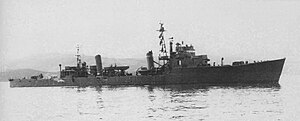 Kiri after the war, 1945
| |
| History | |
|---|---|
| Name | Kiri |
| Namesake | Paulownia |
| Builder | Yokosuka Naval Arsenal |
| Laid down | 1 February 1944 |
| Launched | 27 May 1944 |
| Completed | 14 August 1944 |
| Stricken | 5 October 1945 |
| Fate | Transferred to the Soviet Navy, 29 July 1947 |
| Name | Kiri |
| Acquired | 29 July 1947 |
| Commissioned | July 1947 |
| Renamed |
|
| Reclassified |
|
| Stricken | 20 December 1969 |
| Fate | Scrapped after 20 December 1969 |
| General characteristics (as built) | |
| Class and type | Matsu-class escort destroyer |
| Displacement | 1,282 t (1,262 long tons) (standard) |
| Length | 100 m (328 ft 1 in) (o/a) |
| Beam | 9.35 m (30 ft 8 in) |
| Draft | 3.3 m (10 ft 10 in) |
| Installed power | 2 × water-tube boilers; 19,000 shp (14,000 kW) |
| Propulsion | 2 shafts, 2 × geared steam turbines |
| Speed | 27.8 knots (51.5 km/h; 32.0 mph) |
| Range | 4,680 nmi (8,670 km; 5,390 mi) at 16 knots (30 km/h; 18 mph) |
| Complement | 210 |
| Sensors and processing systems | |
| Armament |
|
Kiri (桐, "Paulownia") was one of 18 Matsu-class escort destroyers built for the Imperial Japanese Navy (IJN) during World War II. Completed in mid-1944, the ship played a minor role in the Battle off Cape Engaño in October and began escorting convoys the following month. She was moderately damaged by American aircraft while escorting a troop convoy in December. Kiri returned to Japan in January 1945 for repairs and escorted a convoy to Japanese Formosa later that month. Her activities for the rest of the war are unknown.
The ship was surrendered to the Allies at the end of the war and used to repatriate Japanese troops until 1947. Mid-year the destroyer was turned over to the Soviet Union and was commissioned into the Soviet Navy. She was renamed Vozrozhdionny (Возрождённый (Resurrected)). When the ship was converted into a target ship in 1949, she was renamed TsL-25. The vessel was hulked and renamed PM-65 in 1957 and ordered to be scrapped in 1969.